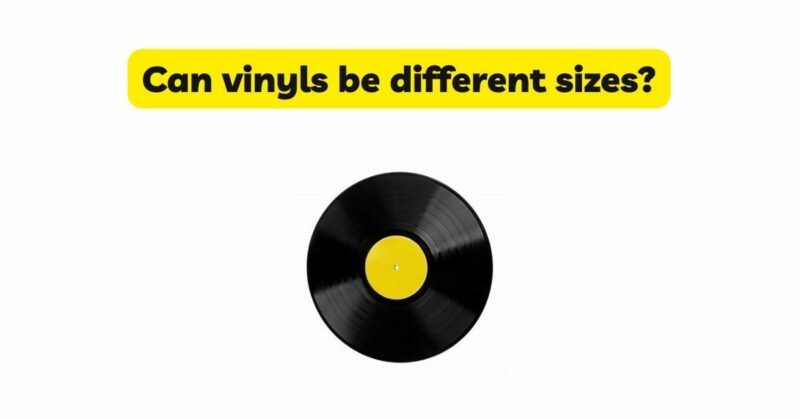Vinyl records have seen a resurgence in popularity, captivating music enthusiasts with their warm, analog sound and nostalgic charm. One intriguing aspect of vinyl records is their ability to exist in different sizes. In this article, we will explore the versatility of vinyl records and examine the various sizes available in the format. From the common 7-inch and 12-inch records to the more unconventional sizes, we will delve into the world of vinyl and its diverse range of sizes.
- The Common Sizes: The most widely recognized sizes of vinyl records are the 7-inch and 12-inch formats. The 7-inch vinyl, often referred to as a single, typically contains one song per side, providing a concise musical experience. On the other hand, the 12-inch vinyl is associated with full-length albums, offering an immersive journey with extended playtime. These sizes have become the industry standard for vinyl records and are readily available in music stores and online platforms.
- 10-Inch Vinyl: While less common than the 7-inch and 12-inch formats, the 10-inch vinyl holds its own unique place in the world of records. Falling between the compactness of a single and the fullness of a standard album, 10-inch records offer a middle ground for artists and collectors. They often feature extended play (EP) releases or shorter albums with a more focused musical experience. The 10-inch size allows for additional tracks compared to a 7-inch single while maintaining a more compact form than a 12-inch record.
- Specialty Sizes: Beyond the common sizes, vinyl records can also come in specialty sizes that add novelty and uniqueness to a collection. These sizes are often used for limited editions, special releases, or promotional purposes. Examples of specialty sizes include 5-inch (known as the “mighty mini”), 8-inch (used for picture discs and special editions), and even larger formats like 15-inch or 18-inch records. These non-standard sizes add a touch of exclusivity and intrigue for collectors seeking something different.
- Shaped Vinyl: Another fascinating aspect of vinyl records is the ability to produce them in unconventional shapes. Shaped vinyl takes the form of objects, symbols, or images related to the artist or album theme. These records require custom-made molds and pressing techniques to create the desired shape. While shaped vinyl may sacrifice some audio fidelity due to the unique grooves, they offer a visually striking and collectible addition to any vinyl collection.
- Flexi Discs: Flexi discs, also known as flexi records or phonosheets, represent a flexible and lightweight format of vinyl records. Made from thin and bendable material, these discs often come as inserts in magazines, promotional materials, or limited releases. Flexi discs have a lower audio quality compared to standard vinyl records but are prized for their unique nature and historical significance. They serve as ephemeral and collectible items that showcase the versatility of vinyl as a medium.
- The Impact on Sound Quality: While vinyl records can come in different sizes, it’s important to note that the size itself does not directly affect the sound quality. The quality of sound reproduction primarily depends on factors such as the mastering process, pressing quality, and overall condition of the record. The size of the vinyl affects the playtime available per side, which can influence the audio fidelity due to the amount of information packed into the grooves. However, this difference in playtime is more noticeable when comparing the common sizes like 7-inch and 12-inch records rather than different variations within a size category.
- Collectibility and Rarity: The varied sizes of vinyl records contribute to their collectibility and rarity. Limited edition releases or special editions in non-standard sizes oftenbecome highly sought after by collectors due to their uniqueness and scarcity. Unconventional sizes, such as shaped vinyl or flexi discs, offer a distinctive appeal that appeals to collectors looking for something out of the ordinary. These records hold a special place in the collector’s market and can command higher prices due to their limited availability and novelty factor.
Conclusion: The world of vinyl records is a testament to the medium’s versatility and adaptability. Vinyl records can be found in a range of sizes, from the common 7-inch and 12-inch formats to the less conventional 10-inch and specialty sizes. Each size offers its own unique experience, whether it’s the concise musical journey of a 7-inch single, the immersive exploration of a 12-inch album, or the middle ground provided by a 10-inch record.Additionally, vinyl records can take on unconventional forms, such as shaped vinyl and flexi discs, adding novelty and collectibility to the format. These non-standard sizes and formats serve as visually captivating pieces that further highlight the diversity of vinyl records.While the size of a vinyl record itself does not directly impact the sound quality, it does influence playtime per side and can affect the overall listening experience. However, it’s important to note that the audio fidelity primarily depends on other factors such as mastering and pressing quality.Ultimately, the varied sizes of vinyl records offer something for everyone, catering to different preferences, artistic visions, and collector’s desires. Embrace the diversity of vinyl sizes and formats, explore the unique offerings they bring, and enjoy the distinct experience that each size and shape provides in the world of vinyl records.


